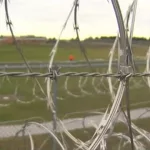
BURLINGTON, Vt. (WCAX) – There were 11 deaths in the Vermont prison system in 2023. Most of them were by suicide or natural causes, but two of them were overdoses from illegal drugs that made it behind prison walls. Jeff Nichols was one of them.
Tony Nichols shares pictures and stories of his son Jeff, an avid hunter, and a proud father who never left the part of rural Franklin County where he grew up. “He was a good man,” Tony said. “He was our boy who said he wasn’t going to leave the hill.”
Nichols got into a car accident in 2004 when he was 16. It left him in the hospital for months and his father says the pain medication he was prescribed led to a dependency on opioids. “I think he was addicted. My son had some issues being from the opioid crisis,” he said.
That addiction led to numerous scrapes with the law, including arrests for four felonies and 15 misdemeanors. And then came the arrest on a Friday night in September for allegedly assaulting his girlfriend at their home in Sheldon. Police dash and body camera videos show police searching Nichols before he is put in the cruiser and the trooper asking if he’s been using drugs or has any on him. “So you don’t got any needles or anything in your pockets?” the trooper asked. In the video provided to WCAX, Nichols’ response is not audible.
After his arrest, Nichols was taken to the Vermont State Police barracks where he was screened and processed. A few hours later he was brought to the Northwest State Correctional Facility around 3 a.m. on Saturday the 9th. His father, who was out of state, decided to not bail him out immediately. “I told him we will get him Monday. Let him take a break, breathe, he can’t get hurt in there — and he did,” Tony said.
At 6:32 a.m. Sunday, Nichols was found unresponsive in his cell. After the opioid reversal drug Narcan was administered and other life-saving measures were attempted, he was pronounced dead at 6:49 a.m., just 27 hours after arriving at the prison.
His dad remains tormented by the thought that it would have been different if he’d bailed his son out that night.
Reporter Ike Bendavid: You think about that and what comes to mind?
Tony Nichols: I screwed up. I screwed up.
He’s also left to wonder how his son was able to die from a drug overdose while in state custody. “Who gave him the drugs? Where did he get the fentanyl that killed him? He had to have gotten it in there,” Tony said.
According to his autopsy report, Nichols died from a mix of fentanyl and hydroxyzine, a drug used to treat anxiety. Corrections officials say offenders sometimes swallow drug packets or hide them in body cavities before going to prison.
But Nichols’ dad says his son was unaware of the police in his house before his arrest and didn’t have time to plan to hide or ingest any drugs. “No chance. How could he if they turned around and they had the element of surprise? There’s no way once that police officer got contact with him, the eyes never left him,” he said.
“I don’t envy the position of the department but I think we have all identified that as a weak point,” said Vermont Defender General Matt Valerio. He has been critical of the emergency responses inside correctional facilities, but he admits that many of the people inside the prison are already in bad health or addicted to substances. “I think what you are seeing is a reflection on the inside of what you are seeing on the outside.”
Valerio says drugs getting inside prison are rare but that they do make it inside. According to the state, corrections officials do not get screened but visitors and inmates do. “And it’s basically anyone that comes into a facility — it’s not everybody of course — but that’s how they come in, there’s no magic to it,” Valerio said.
Vermont Corrections Commissioner Nick Deml wouldn’t comment specifically on the Nichols case because it remains under investigation, but he says despite current security measures, he admits drugs are getting inside prisons. There were eight overdoses at Vermont prisons last year with two of them fatal, including Nichols.
“We are troubled by that. It’s something that we are taking very seriously and we know that mirrors the troubles in our community, too,” Deml said. He says 60% of the people in DOC custody are addicted to opioids. “It’s very frightening to see how people are presenting to our correctional system right now from the community.”
But there may be a silver lining to this grim picture — growing success in getting inmates with substance use disorder into drug treatment. Deml says 70% of the inmates who went on medical-assisted treatment in the last five years have stayed on the program. “That indicates to me that 70% of the folks that we treated inside the walls are continuing to get treatment outside the walls,” he said.
Valerio agrees. “We are much better off with our medically assisted treatment of opioid disorder and the like than we have ever been,” he said.
But that’s little solace to Tony Nichols, whose son can’t be counted in that success story. “I’m gonna miss him… a lot,” he said.
One question that arose from Jeff Nichols’ death is how inmates suspected of substance use disorder are cared for when they first arrive in prison. We’re told they are given some basic medication to fight withdrawal symptoms and monitored for signs of detox every 15 minutes. State lawmakers are beginning an examination of health care in prisons and how it can be improved.
The investigation into Jeff Nichols’ death is expected to be completed later this year.
